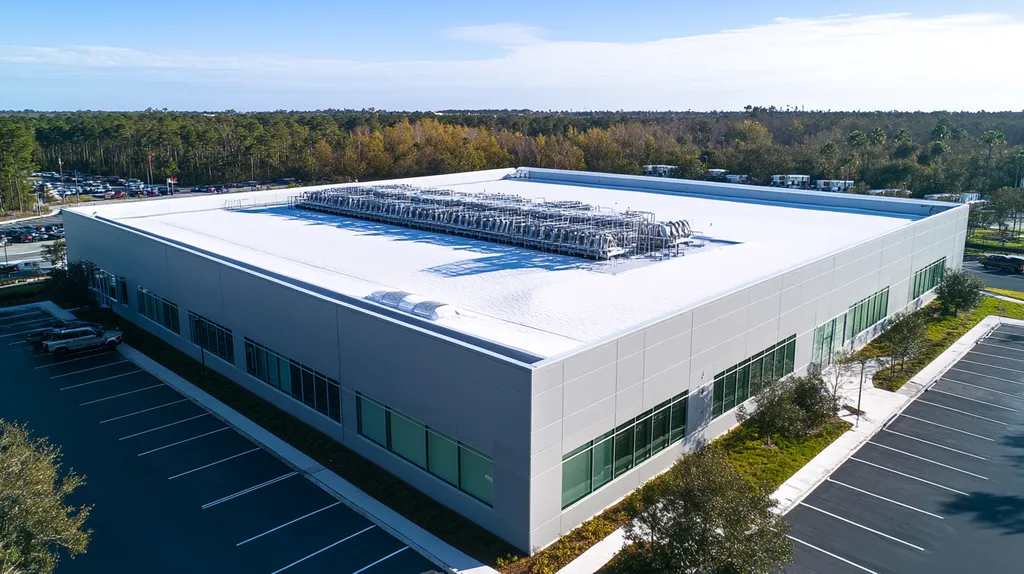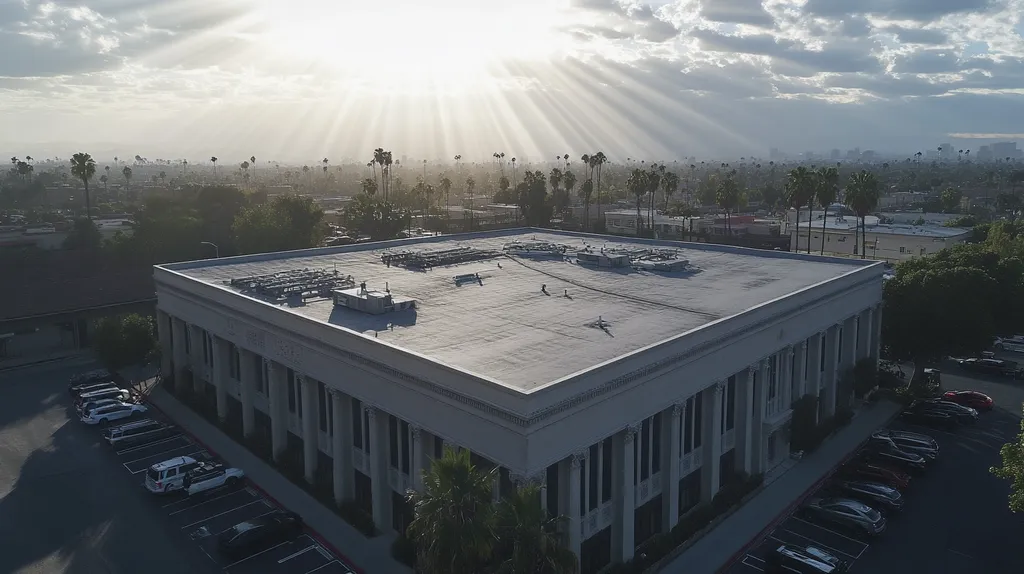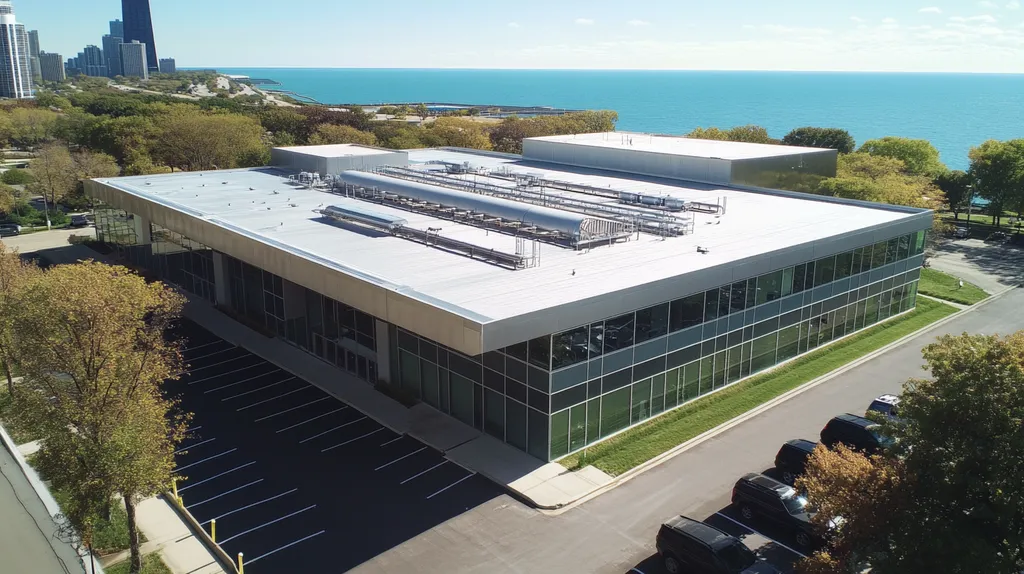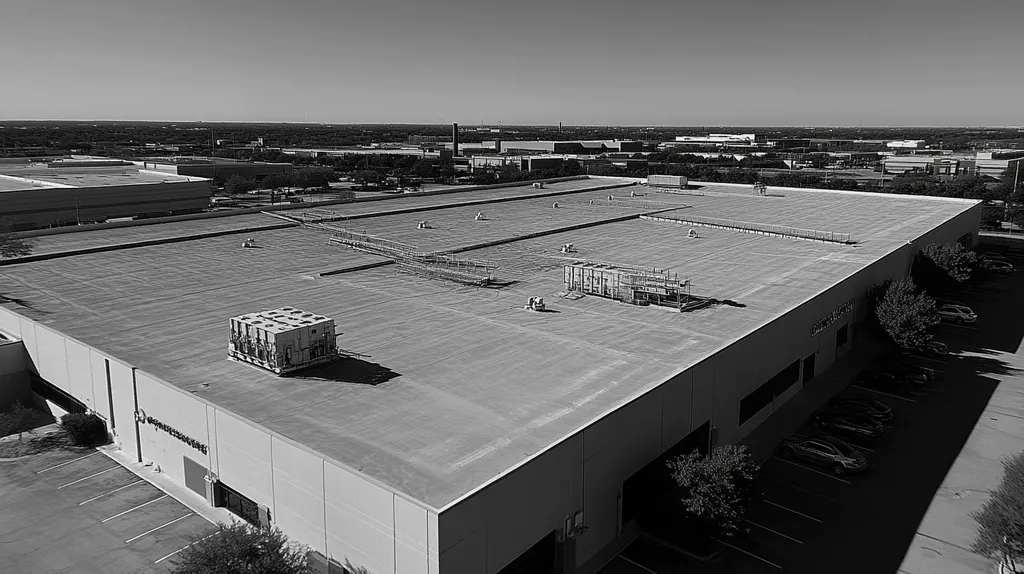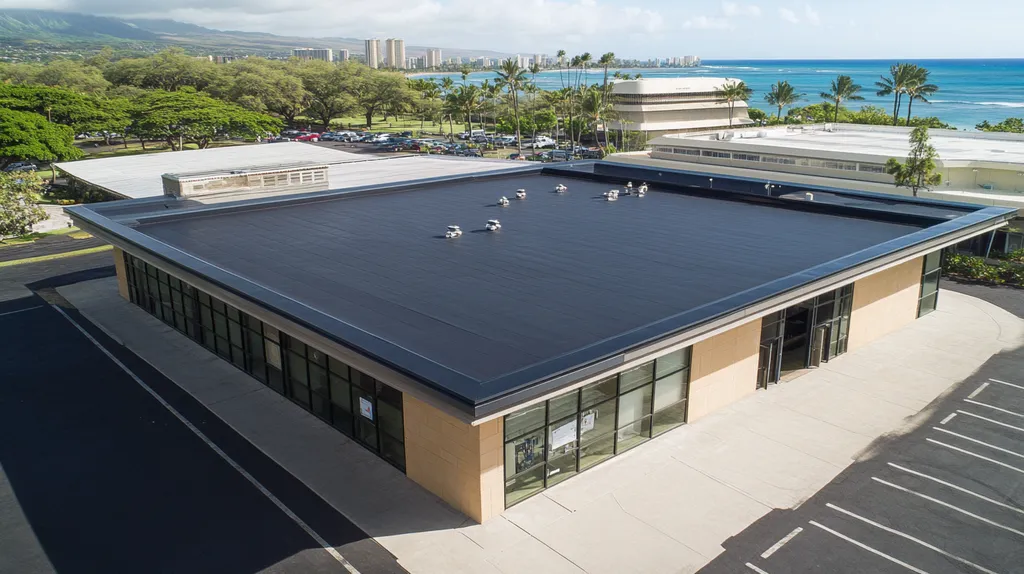Every year, industrial fires cause over $1.2 billion in property damage, with nearly 30% originating from inadequately maintained fire-resistant roofs. This staggering statistic underscores a critical gap in facility management practices.
Despite advances in roofing technology, widespread misconceptions continue to compromise safety and increase vulnerability to catastrophic losses. From misunderstanding fire ratings to neglecting essential maintenance, these myths put facilities at unnecessary risk.
This comprehensive guide examines six crucial aspects of fire-resistant industrial roofing, debunking common myths while providing evidence-based solutions for facility managers seeking to enhance safety and protect valuable assets.
SECTION 1: COMMON MISCONCEPTIONS
Misunderstandings about fire-resistant industrial roofs can lead to catastrophic outcomes. Many facility managers cling to outdated beliefs that increase vulnerability to fire damage and expensive repairs. The ramifications can be severe, as research indicates that just one fire incident can cause significant operational downtime and financial loss. This section addresses three common misconceptions that threaten safety and effective maintenance.
All Roofing Materials Are Fire-Resistant
A widespread misconception is that all roofing materials inherently offer fire resistance. Many property owners mistakenly assume that new industrial roofs come equipped with this essential feature. In reality, only specific materials, like certain types of modified bitumen or metal, are engineered for effective fire resistance.
For instance, several commonly used roofing membranes are classified as combustible and exhibit varying levels of resistance to flames. This misunderstanding can expose facilities to serious fire hazards. Selecting appropriate materials is crucial; therefore, understanding product fire ratings is essential for maintaining safety and compliance.
Mischaracterizing materials’ fire resistance can lead to poor roofing system choices. This may result in increased insurance premiums and diminished asset value. Facility managers are encouraged to conduct comprehensive research or consult experts when evaluating roofing alternatives.
By insisting on fire-rated materials and verifying their certifications, facility managers can enhance safety. Staying informed about material properties is vital for sound decision-making and safeguarding investments.
New Roofs Do Not Require Fire Safety Inspections
Some facility managers mistakenly believe newly installed roofs don’t need fire safety inspections. This assumption is risky, as many new installations may have concealed defects that compromise fire resistance. Even a brand-new roof can be vulnerable to installation errors that introduce significant risks.
Regardless of their newness, roofing systems can suffer from poor workmanship or inferiority in materials. According to fire safety organizations, a notable percentage of roof fires stems from installation deficiencies. Overlooking the need for inspections can have dire consequences if a fire occurs.
Conducting regular inspections after installation can uncover potential fire hazards and ensure compliance with current fire codes. Establishing a routine for ongoing evaluations is not only wise but also a financially sound strategy.
Incorporating routine fire safety inspections into maintenance plans is essential to protect facilities from unforeseen issues. These proactive measures safeguard both assets and the well-being of personnel.
DIY Roof Repairs Are Safe and Effective
Many facility managers mistakenly believe that do-it-yourself roof repairs are both safe and effective. This misconception poses significant risks, as improper repairs can jeopardize a roof’s fire resistance and overall integrity. Depending on untrained staff for roofing issues can result in unnoticed deficiencies that may escalate into more severe problems.
For example, small leaks might seem harmless, but when neglected, they can create conditions that facilitate fire spread. The relationship between minor repairs and major fire hazards is often underestimated, making this belief particularly dangerous.
Moreover, workers may lack the necessary expertise to perform safe and compliant repairs, compounding the risk. Hiring qualified roofing professionals not only ensures that repairs are done correctly but also bolsters fire resistance performance.
Investing in professional services offers peace of mind and can save costs in the long term by mitigating the risk of fire-related incidents. Facility managers should prioritize expert involvement in all repair and maintenance efforts.
SECTION 2: PRACTICAL IMPLICATIONS
The importance of maintaining fire-resistant industrial roofs cannot be overstated. Alarmingly, a recent study revealed that nearly 60% of roof fires are linked to inadequate maintenance or installation errors. Facility managers must recognize that misinformation surrounding roofing practices can significantly jeopardize roof durability and safety, leading to expensive repairs and potential legal liabilities. This section delves into how neglecting regular upkeep and employing improper installation techniques can trigger severe consequences for facility operations.
Impact of Misinformation on Roof Durability
Misinformation about fire-resistant roofing often prompts facility managers to underestimate necessary maintenance protocols. For instance, many may wrongly believe that fire-resistant materials are entirely fireproof, which is misleading. Without proper care, even the most robust materials can lose their protective capabilities over time, increasing the risk of fire hazards.
Incorrect information can lead to poor material selection and inadequate maintenance routines. As a result, the effectiveness of fire-resistant roofs diminishes, exposing facilities to heightened danger in the event of a fire—an outcome that informed decisions could have prevented.
Furthermore, outdated practices can be perpetuated through casual conversations, fostering a false sense of security among facility managers. Organizations that embrace misinformation are likely to incur frequent roof failures and may face legal consequences for safety violations.
To mitigate the risks, facility managers must actively pursue accurate information and seek expert guidance. This approach not only protects their investments but also ensures the safety of the people who work within those facilities.
Consequences of Neglecting Regular Maintenance
Neglecting regular maintenance on fire-resistant roofs can lead to disastrous outcomes. Routine inspections are crucial for spotting issues like deteriorating seams or debris damage, allowing for timely interventions before they escalate. Ignoring small concerns can lead to extensive damage that jeopardizes the entire roof structure.
For example, a warehouse with a neglected roof could experience a catastrophic fire, resulting in substantial financial losses and damage to its reputation. Additionally, insurance companies may deny coverage for facilities that can prove neglect, complicating recovery efforts after incidents.
Incorporating regular maintenance, which includes thorough cleaning and prompt repairs, can significantly extend the life of a roof. Facility managers should establish a comprehensive maintenance schedule to safeguard both the property and the personnel who rely on it.
Neglecting upkeep not only leads to higher repair costs but can also weaken the fire-resistance rating of roofing materials. Such deterioration is completely avoidable through diligent maintenance practices.
Risks of Improper Installation Techniques
The risks associated with improper installation techniques for fire-resistant roofs are significant. Mistakes made during installation can undermine the fire-resistance capabilities of roofing materials. If seams are not adequately sealed or incompatible materials are used, the roof’s performance during a fire can be severely compromised.
Hiring unqualified contractors heightens this risk. Lack of training in proper installation techniques can lead to critical oversights. Facility managers should prioritize engaging accredited professionals who specialize in fire-resistant roofing to ensure compliance with safety standards.
Moreover, flawed installation can result in costly operational downtime, hindering productivity and causing financial losses. Conducting a thorough review of installation practices is essential for preserving fire-resistant capabilities and maintaining efficient operations.
In summary, the implications of improper installation techniques underscore the need for strict adherence to best practices, reinforcing the essential link between quality installation and facility safety.
SECTION 3: COST OF MISINFORMATION
The financial impact of misinformation in roofing decisions can reach alarming heights. Industry studies show that a premature roof failure can result in losses exceeding $100,000 for facility managers. When faulty information influences maintenance practices, these costs only escalate, complicating the already challenging landscape of facility management. This section explores the steep financial consequences of such misinformation, unveiling the stark differences between reactive and proactive maintenance strategies.
Financial Consequences of Premature Roof Failure
Facility managers frequently underestimate the financial toll that premature roof failures can inflict. A well-built industrial roof is designed to last over 20 years, but misinformation can significantly shorten this lifespan. For example, inadequate installation or the absence of routine inspections can result in severe leaks and structural deterioration.
The immediate costs of roof failure encompass not just repair or replacement bills but also lost production time and possible damage to equipment or inventory. These hidden expenses can rapidly accumulate, leading to financial losses in the six-figure range.
Additionally, a compromised roof can have a ripple effect on insurance premiums. Frequent claims can prompt insurance providers to raise rates or deny coverage altogether, exacerbating the financial strain on a facility’s budget.
In conclusion, misinformation regarding roof maintenance practices can adversely impact not only immediate repair costs but also long-term financial stability for industrial facilities.
Hidden Costs of Reactive Maintenance
While reactive maintenance may seem cost-effective in theory, it often conceals hidden costs that can devastate budgets. When facility managers only address issues after they arise, they risk incurring exorbitant repair expenses that could have been prevented. For instance, neglecting minor leaks can escalate into major water damage, necessitating extensive repairs.
Moreover, operational disruptions caused by emergency repairs can hinder productivity. Work stoppages and potential equipment damage further inflate costs, disrupting production schedules and cutting into profits.
The stress of dealing with reactive maintenance can also drain valuable resources and lead to poor decision-making, creating a detrimental cycle where misinformation continues to affect maintenance strategies.
Ultimately, while reactive maintenance might appear to save money initially, it frequently leads to far greater expenses down the line.
Long-Term Savings Through Proactive Maintenance
Embracing proactive maintenance is a game-changing best practice that yields substantial long-term savings. Regular inspections and scheduled repairs may seem like an unnecessary expense but can prevent larger, more costly issues from arising. By investing in proactive measures, facility managers can extend the lifespan of their roofs and maintain structural integrity.
A simple inspection can uncover early signs of wear, such as cracks, before they escalate into serious problems. This type of early intervention can protect investments by saving thousands in potential repairs. Research indicates that proactive maintenance can decrease long-term roofing costs by as much as 30%.
Additionally, a proactive maintenance approach fosters a safer working environment, thereby reducing the risk of accidents related to roof failures. As a bonus, this commitment to safety can also result in lower liability insurance premiums over time, providing further financial advantages.
In essence, transitioning from a reactive to a proactive maintenance strategy empowers facility managers to make well-informed decisions, ultimately safeguarding their assets and ensuring financial stability.
SECTION 4: REALITY CHECK
Fire resistance must be at the forefront of any facility manager’s mind when it comes to industrial roofs. With the stakes so high—one fire incident can destroy a facility’s assets and reputation—understanding fire resistance ratings is imperative. Misunderstandings can lead to catastrophic outcomes, including increased insurance costs and potential legal issues. This section clarifies fire resistance ratings, compares TPO, PVC, and EPDM roofing materials, and highlights successful real-world applications of fire-resistant roofs.
Fire Resistance Ratings Explained
Fire resistance ratings serve as critical indicators of how well a roof can withstand fire exposure. These ratings are established through standardized tests such as ASTM E108 and UL 790. The classification of a roof can directly influence insurance premiums and compliance with safety regulations.
Roofs are categorized into Class A, B, or C, with Class A representing the highest level of fire resistance. Class A roofs can endure severe fire exposure, while Class B and C roofs are rated for lighter conditions. Facility managers must grasp these ratings to make informed choices regarding which roofing system best suits their facilities.
Ignoring these distinctions can expose a facility to risk. Not all roofing materials are fire-resistant, and selecting a roof without understanding its fire rating can compromise safety and business continuity.
Ultimately, fire resistance ratings provide a roadmap for making knowledgeable decisions. Property owners should collaborate closely with roofing experts to ensure their systems meet fire safety standards.
Comparing TPO, PVC, and EPDM Fire Resistance
When it comes to fire resistance, TPO, PVC, and EPDM roofing materials offer distinct benefits and limitations. Thermoplastic Olefin (TPO) roofs are lauded for their good fire resistance, often achieving a Class A rating when installed correctly. However, the quality of maintenance and installation is pivotal for optimal performance.
Polyvinyl Chloride (PVC) roofs also boast excellent fire-resistant characteristics. Their chemical stability allows them to withstand high temperatures without deforming. Nonetheless, precise installation is essential to mitigate any fire risks.
Ethylene Propylene Diene Monomer (EPDM) roofs, while not inherently fire-resistant, can be enhanced with fire-retardant additives. The effectiveness of EPDM roofs in fire scenarios largely depends on these treatments and the regular maintenance applied to them.
Choosing the right material involves careful assessment of their fire ratings and overall performance, enabling facility managers to significantly reduce fire-related risks.
Real-World Examples of Fire-Resistant Roofs
Various industries have successfully implemented fire-resistant roofing systems. For instance, a manufacturing plant that installed a TPO roof rated Class A saw a marked decrease in fire hazard risks. Following this upgrade, the facility experienced lower insurance premiums due to improved safety standards.
Another example features a distribution center utilizing PVC roofing. By meticulously following installation protocols, the center effectively minimized fire exposure while remaining compliant with safety regulations, safeguarding invaluable inventory and ensuring seamless operations.
EPDM roofing also shines in industrial applications. A warehouse that applied fire-retardant coatings to its EPDM roof passed all fire safety inspections, preventing costly repairs and potential downtimes.
These success stories underscore the profound importance of investing in fire-resistant roofing systems. Facility managers dedicated to fire safety can better protect their assets and ensure long-term operational success.
SECTION 5: EVIDENCE-BASED ALTERNATIVES
Fire-resistant roofing is more than just a regulatory requirement—it’s essential for protecting lives and assets. Alarmingly, the National Fire Protection Association reports that nearly half of all commercial building fires originate on the roof. Choosing the right fire-resistant materials can dramatically mitigate these risks while ensuring compliance with industry standards. This section discusses evidence-based alternatives that facility managers should seriously consider to enhance their roofing systems against fire hazards.
Selecting the Right Fire-Resistant Materials
Choosing fire-resistant materials is crucial for protecting facilities and ensuring safety. Today, a variety of roofing options, such as modified bitumen, thermoplastic polyolefin (TPO), and metal roofing systems, are engineered to meet specific fire safety standards, effectively reducing the risk of ignition and fire spread.
Facility managers should examine manufacturers’ specifications for fire resistance, focusing on products rated for high-temperature performance and those that offer warranties covering fire damage. Selecting the right materials can create a durable barrier, enhancing safety and extending the lifespan of the roof.
Installation is another critical factor affecting fire performance. Improper installation can diminish the effectiveness of fire-resistant materials. Therefore, working with certified roofing contractors knowledgeable in fire-resistant options is vital for achieving optimal performance.
Regular training for roofing contractors on best practices can elevate safety standards during installations. By investing in premium materials and specialized expertise, facility managers can cultivate a robust defense against fire-related risks.
Importance of ASTM and Class A Ratings
A deep understanding of fire ratings is vital for selecting the most suitable roofing materials. The American Society for Testing and Materials (ASTM) provides test methods and standards to evaluate fire resistance. Class A ratings signify the highest level of fire resistance, making these materials highly suitable for industrial settings.
Facilities equipped with Class A rated roofs often benefit from lower insurance premiums, as these roofs are viewed as lower risk by insurers. A Class A roof is less likely to ignite and can effectively slow the spread of fire, providing critical time for evacuation and emergency response.
Facility managers must ensure that the roofing products they choose have valid ASTM ratings, which serve as certified endorsements of fire safety. Disregarding these standards can result in dangerous choices that jeopardize lives and property.
Moreover, local building codes frequently cite ASTM ratings for compliance. Utilizing materials that meet or exceed these ratings not only safeguards facilities but also ensures adherence to legal requirements, thereby protecting both assets and personnel.
Benefits of Regular Professional Inspections
Regular professional inspections are an indispensable aspect of maintaining fire-resistant roofs. Over time, roofing systems can suffer wear from environmental factors, leading to vulnerabilities that increase fire risk. Schedule inspections allow for the detection of early signs of damage or degradation that could compromise fire resistance.
Early problem identification enables timely repairs, reducing fire hazards. Roofing professionals can also provide insights on maintaining fire-resistant properties and recommend necessary upgrades to enhance safety.
In addition to improving safety, regular inspections can prolong the overall lifespan of roofing systems. By investing in consistent evaluations, facility managers can ensure their roofs perform efficiently, minimizing future replacement costs.
Facilitating regular inspections aligns with proactive safety strategies. Establishing a routine for professional assessments can mitigate potential fire hazards and foster a workplace culture focused on safety.
SECTION 6: TEST AND VERIFY
Ensuring the fire resistance of industrial roofs isn’t just best practice—it’s critical for safety and compliance. Alarmingly, over 22% of industrial facilities have reported fire incidents related to their roofs. Therefore, implementing rigorous testing and verification processes is essential to prevent costly damage and protect lives. This section highlights best practices for conducting fire resistance tests, verifying manufacturer claims, and exploring impactful case studies. Each step is vital for fortifying facilities against fire risks.
Conducting Fire Resistance Tests
Fire resistance tests are fundamental to ensuring roofing materials meet safety standards. The ASTM E108 and UL 790 tests are the gold standards for assessing a roof’s ability to withstand fire exposure. Neglecting these tests can create dangerous misconceptions about a roof’s safety.
Facility managers should partner with certified testing laboratories to obtain unbiased results. Regular testing is essential, especially after any repairs or re-roofing, to ensure ongoing compliance with evolving fire safety standards. Testing should begin with the installation of a new roofing system and continue periodically throughout its lifespan.
Annual inspections are also critical for detecting signs of wear, tear, or damage that could undermine fire-resistant properties. These proactive measures can avert potential fire hazards before they develop into serious issues.
Keeping thorough documentation of all tests is crucial. Maintaining records not only aids in compliance audits but also provides valuable insights into the long-term performance of the fire-resistant roofs.
Verifying Manufacturer Claims and Certifications
Not all fire-resistant roofing materials live up to their claims. Facility managers must rigorously verify manufacturer assertions and industry certifications to avoid falling victim to misleading information. Many manufacturers promote their products as fire-resistant but provide scant evidence of third-party testing.
Reviewing UL listings and NFPA certifications can affirm a product’s fire resistance credentials. These certifications indicate that the roofing materials have undergone strict testing under controlled conditions, ensuring their reliability. Managers should also investigate the fire ratings of materials before finalizing their purchasing decisions.
It’s important to remember that even certified products may react differently in unique conditions. Familiarizing oneself with the intended use and local fire code compliance can prevent incorrect material applications. Regular communication with manufacturers can clarify product capabilities and expected performance.
By establishing a comprehensive vetting process, facility managers can confidently select truly fire-resistant roofing systems, assuring both peace of mind and regulatory compliance.
Case Studies of Successful Fire-Resistant Roofs
Case studies reveal the tangible benefits of fire-resistant roofing systems. Consider a major manufacturing facility in California that adopted a fire-resistant roof. This proactive choice significantly reduced damage after a nearby wildfire ignited an adjacent property, showcasing the importance of preparedness.
In another instance, a Texas warehouse faced a severe roof fire due to a malfunctioning HVAC system. Thanks to their investment in UL-rated roofing materials, the fire was effectively contained, minimizing damage and facilitating a rapid recovery.
These examples underscore that investing in high-quality fire-resistant roofs offers significant long-term savings. The positive outcomes of these case studies reinforce the need for diligent testing and strict adherence to fire safety regulations. Although it may require an initial investment, the benefits in terms of safety and financial stability far outweigh the potential losses associated with fire incidents.
These success stories serve as a powerful reminder of the critical importance of verifying fire resistance in industrial roofing, ultimately highlighting its role as a vital component in fire prevention strategies.
The Bottom Line
With industrial fire damage exceeding $1.2 billion annually, facility managers can no longer afford to maintain outdated assumptions about fire-resistant roofing.
The evidence clearly demonstrates that proper material selection, professional installation, and regular maintenance are non-negotiable elements of an effective fire safety strategy.
By embracing evidence-based practices – including rigorous testing protocols, verified manufacturer certifications, and scheduled professional inspections – facilities can dramatically reduce their vulnerability to catastrophic losses.
The cost of inaction far exceeds the investment required for proper fire-resistant roofing systems, with potential savings of up to 30% in long-term maintenance costs.
Moving forward, facility managers must prioritize fire resistance in their roofing decisions to protect both assets and lives.
FREQUENTLY ASKED QUESTIONS
Q. Are all commercial roofs fire-resistant?
A. No, not all commercial roofs are fire-resistant. Specific materials like modified bitumen or metal provide effective fire protection, while many commonly used membranes may be combustible. It’s vital to understand product fire ratings to ensure safety and compliance.
Q. Do new industrial roofs need fire safety inspections?
A. Absolutely! Newly installed roofs can have hidden defects that compromise fire resistance. Conducting fire safety inspections after installation is essential; it helps identify potential hazards and ensures compliance with current regulations.
Q. Can DIY repairs be safe for industrial roofs?
A. No, DIY repairs can jeopardize fire resistance and roof integrity. Improper repairs can lead to undetected deficiencies that escalate into serious issues. It’s best to hire qualified professionals for expert roofing services and safety compliance.
Q. How does misinformation affect fire-resistant industrial roofs?
A. Misinformation can lead facility managers to underestimate required maintenance protocols. Misleading beliefs about material capabilities can lead to reduced fire resistance and neglect, significantly increasing fire hazard risks in industrial settings.
Q. What are the financial consequences of premature roof failure?
A. Premature roof failures can cost facility managers over $100,000 due to repairs, lost productivity, and damaged assets. Additionally, frequent claims can result in higher insurance premiums or loss of coverage, further straining budgets.
Q. How should I choose fire-resistant roofing materials?
A. Look for materials like modified bitumen, TPO, or metal systems with high fire ratings. Focus on durability and warranties covering fire damage. Proper installation is also crucial for optimal fire resistance performance.
Q. Why is testing and verification important for roofs?
A. Testing and verification ensure that roofing materials meet safety standards, helping to avoid dangerous misconceptions. Regular testing detects wear or damage, ensuring compliance with fire safety regulations and protecting facility assets effectively.

